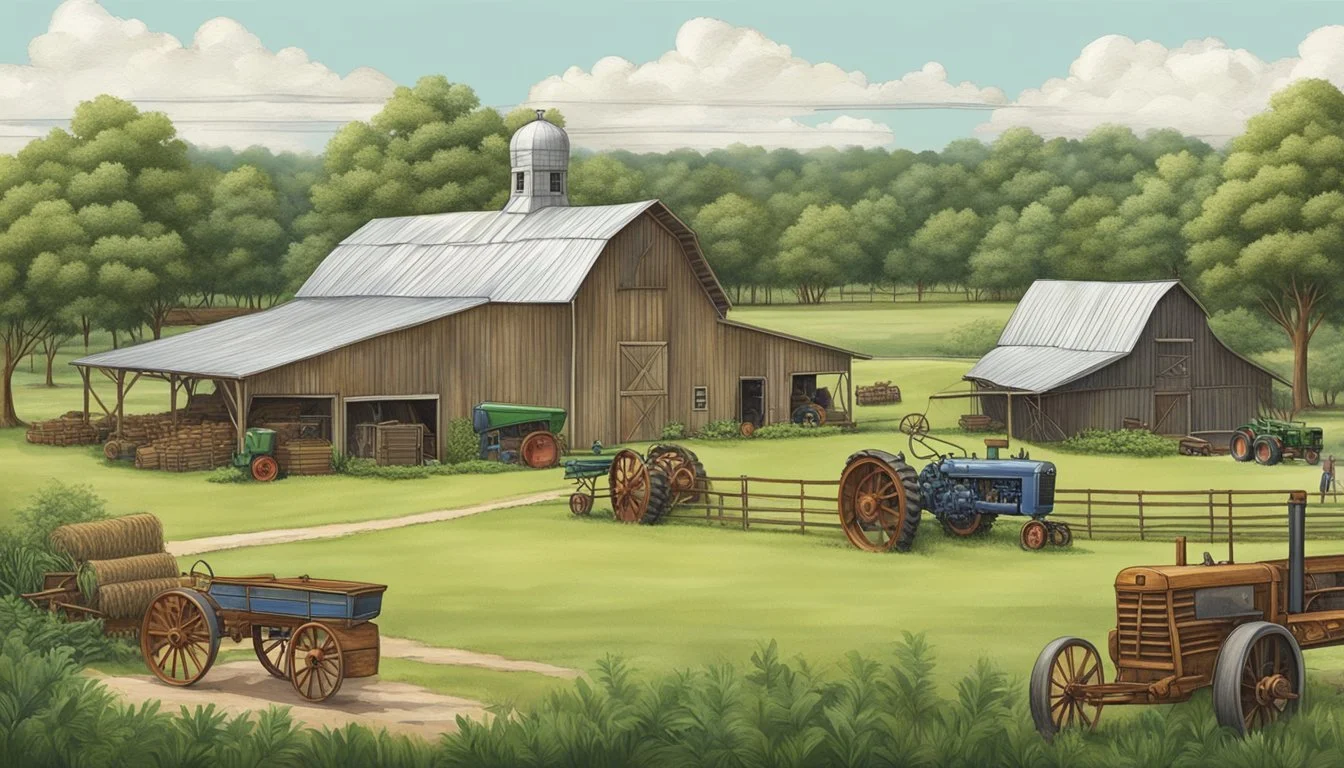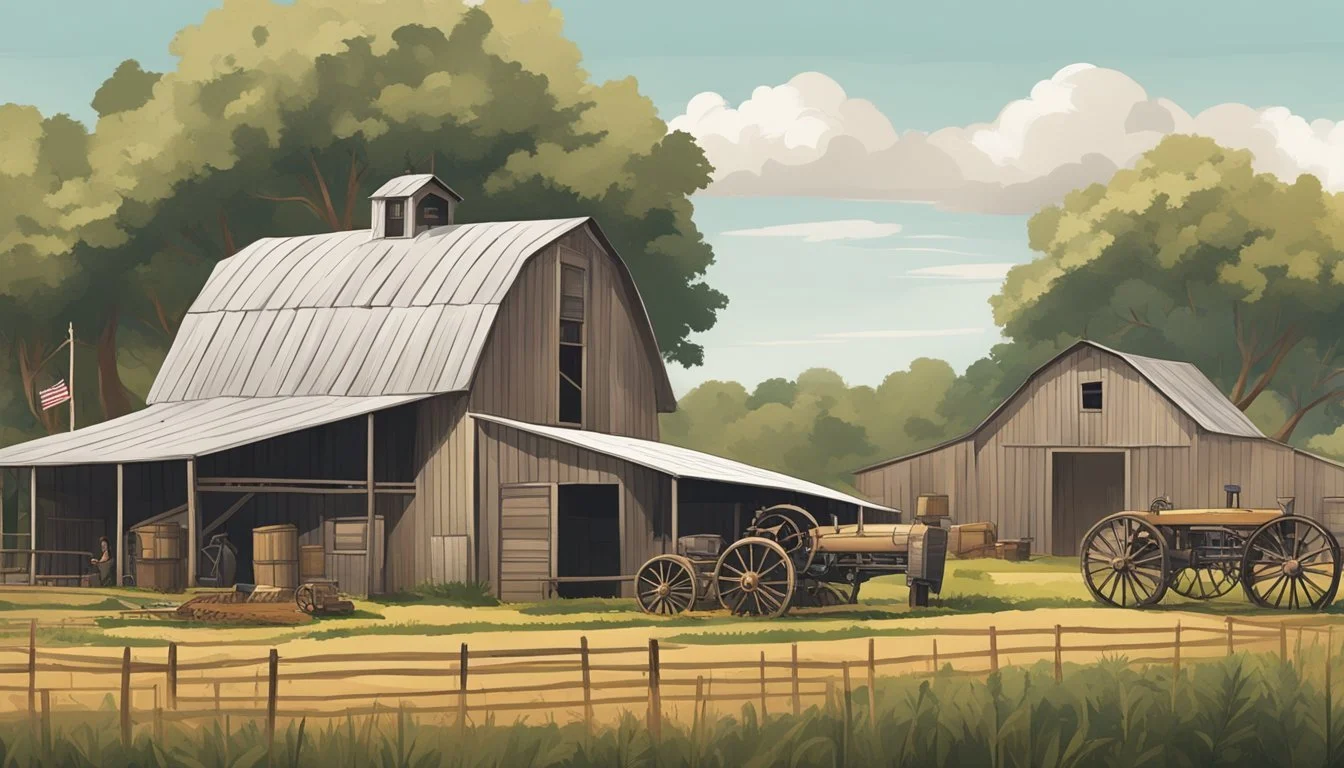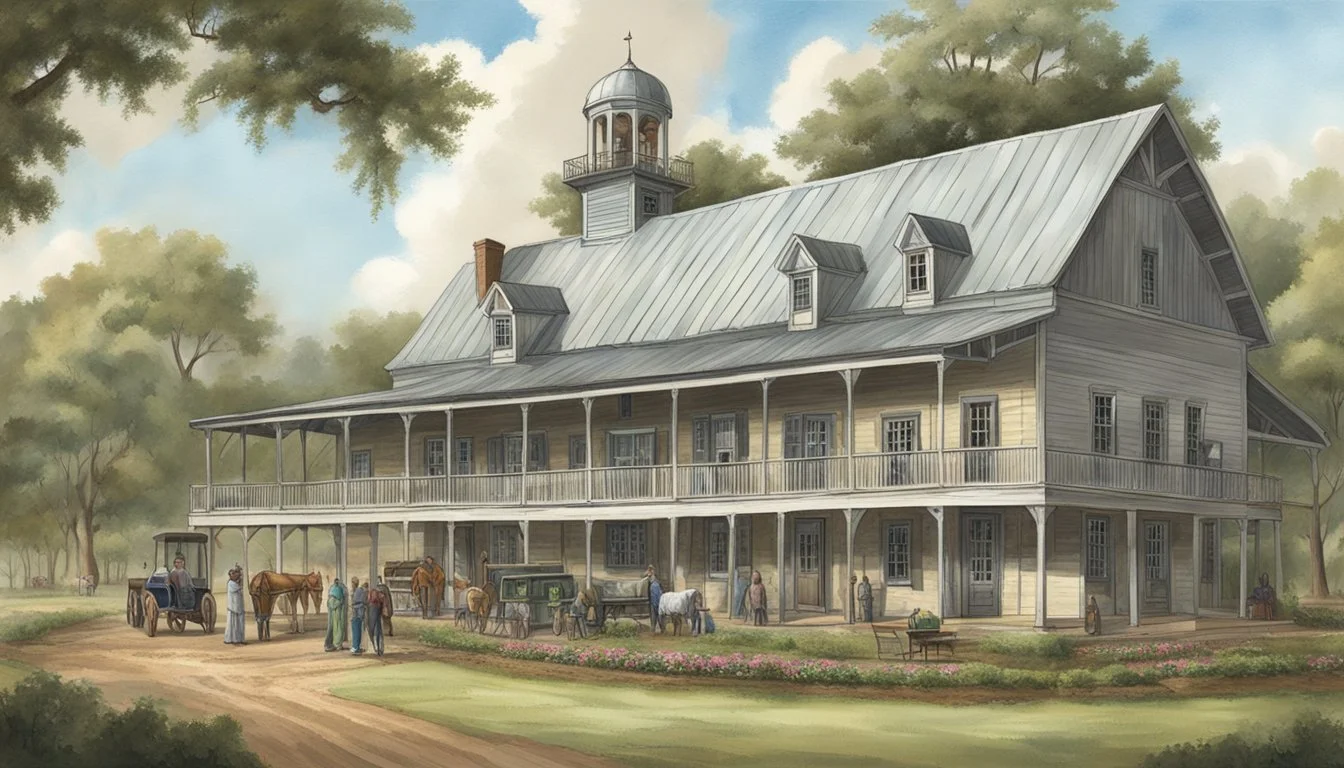Historical Farms and Agricultural Museums in Louisiana
Exploring Heritage and Tradition
Louisiana's rich history is inseparably connected to its agricultural heritage, making historical farms and agricultural museums in the state significant reservoirs of cultural legacy. These sites provide a glimpse into the rural life of the 18th and 19th centuries, reflecting the social and economic fabric of the time. Visitors to the LSU Rural Life Museum can immerse themselves in the daily experiences of early Louisianans, where exhibits and preserved buildings tell the story of working men and women who laid the foundations of the state's agricultural history.
In addition to museums that preserve the past, active agricultural expositions like the Burden Museum & Gardens offer both historical context and a modern perspective on horticulture and farming techniques. They showcase an extensive collection of specialty gardens that demonstrate the botanical diversity fostered by Louisiana's unique climate. The grounds include woodlands, wetlands, and trails that allow visitors to explore and appreciate the natural beauty of the region alongside its farming history.
Exploring these historic sites, such as the working Frogmore Cotton Plantation and Gin, which continues to operate after 200 years, offers an authentic narrative of Louisiana’s agricultural evolution. From handcrafted tools and equipment to the integration of industrial advancements in farming, these historical farms and museums not only document the past but also educate and inspire future generations about the state's agrarian roots.
Historical Overview
Louisiana's agricultural heritage is deeply tied to its diverse cultural influences, including French, Spanish, African, and Acadian traditions. From the cultivation of crops to the architecture of farm estates, the state's history is a tapestry woven through its farms and plantations.
Agriculture in Louisiana's History
Agriculture has been a primary economic driver in Louisiana since the 19th century, with the state's fertile soil contributing to thriving plantations. These working plantations specialized in sugar cane, cotton, and indigo, products that were integral to the Southern economy. Such success, however, was built upon the backs of slaves, an undeniable fact of Louisiana's agricultural past. The blend of cultures, from French and Spanish colonists to African slaves and Acadian settlers, has left an indelible mark on the social and agricultural landscapes.
Evolution of Farms and Plantations
Through the 1800s, Louisiana plantations grew both in number and scale. However, the Civil War brought about a profound transformation, as emancipation and war losses changed the face of the traditional plantation. Post-war, many plantations were broken into smaller farms, altering the socioeconomic fabric of the state. The evolution of agriculture in Louisiana can be directly observed by visiting sites like the Rural Life Museum or the historic plantations along the Great River Road, which preserve the details of these transitions for posterity.
Rural Life Museum
The Rural Life Museum offers visitors an authentic glimpse into the agricultural history and heritage of Louisiana. Providing a unique journey through time, it features historically significant artifacts and structures.
LSU Rural Life Museum Overview
The LSU Rural Life Museum, located in Baton Rouge, serves as a gateway to Louisiana's past, predominantly focusing on the 19th century. The museum is designed to educate visitors on the lifeways of pre-industrial Louisiana residents through an extensive collection of tools, utensils, furniture, and farming equipment.
Exhibits and Collections
The museum boasts over 32 historic structures spread across its 25-acre site, neatly categorized into:
The Working Plantation: This area simulates plantation life, complete with original slave quarters, a blacksmith's shop, and a sugar house.
The Upland South Region: Showcasing artifacts and buildings common to Louisiana's upland south areas.
The Gulf Coast Region: Highlighting the life and architecture of the region's Gulf Coast.
Exhibit Barn: Home to an array of artifacts representative of rural Louisiana life.
These exhibits are designed to offer an immersive experience, meticulously preserved to maintain historical integrity and promote educational understanding of the past.
Windrush Gardens
Adjacent to the museum, Windrush Gardens encompasses 25 of the 400-acre Burden property, providing a living exhibit of the ornamental horticulture typical of a 19th-century plantation. The gardens are open year-round, inviting visitors to wander through its paths and appreciate the serenity and beauty that has been preserved throughout the years.
This educational institution has established itself as one of the premier outdoor museums, earning recognition for contributing significantly to the preservation and understanding of rural history in Louisiana.
Guided Tours and Experiences
Louisiana's agricultural museums and historical farms offer visitors interactive Guided Tours and Educational Programs highlighting the state's rich agricultural past. These experiences allow participants to engage with Living History and gain insights into traditional farming practices through immersive demonstrations and organized tours.
Living History Demonstrations
Visitors can witness history come to life at Kelly's Landing Agricultural Museum & Agri Tours, where they can take a nostalgic walk through antique farm equipment and toy tractor collections. Here, the Living History is palpable, with tools that span generations providing a tangible connection to agricultural heritage. All tours require an appointment, ensuring a personalized experience.
Educational Programs and Tours
For a more comprehensive learning experience, the LSU Rural Life Museum extends its Educational Programs to include a self-guided tour of the outdoor museum and Windrush Gardens. The organization encourages visitors to allocate a minimum of two hours to explore the museum's artifacts and additional time for the gardens. These programs are designed to educate members and guests about Louisiana's historical rural lifestyle.
Cultural Representation
Louisiana's historical farms and agricultural museums are windows into the region's rich cultural mosaic, reflecting influences from French, Spanish, African, and Acadian heritages. These sites preserve not only architecture and folk traditions but also tell the stories of the people who shaped the land.
Influence of Diverse Cultures
In Louisiana, the interweaving of various cultures is evident across historical farms and museums. French and Spanish legacies are particularly prominent, with many sites displaying the cultural nuances of these European colonizers through language, customs, and legal systems. The African influence remains powerful, seen in the music, food, and spiritual practices that reverberate through Louisiana's rural heritage. The LSU Rural Life Museum, for example, showcases Louisiana's historical diversity, capturing life in the working plantation and regions like the Gulf Coast, which have been shaped by a mix of Indigenous, European, and African cultures.
Architecture and Folk Traditions
The architectural landscape of Louisiana’s historical farms is a testament to the blend of cultures. Typical structures include the Dogtrot House, which reflects the pragmatism of the region's early settlers, integrating natural ventilation in the hot, humid climate. Folk architecture within these sites often exhibits French influence, such as the steep roofs and raised living quarters designed to protect against frequent flooding.
Kitchens within these historic settings also reveal cultural stories. They are places where one can trace the lineage of Louisiana’s famous Creole and Cajun cuisines, born from a fusion of French, Spanish, African, and Acadian gastronomy. This blend of styles and functions makes these historical farms and agricultural museums not only representations of the past but also living illustrations of cultural resilience and fusion.
Farm and Museum Operations
In Louisiana, historical farms and agricultural museums are actively engaged in preserving the legacy of rural life and farming heritage through meticulous preservation efforts and effective museum management.
Preservation Efforts
Historical farms and agricultural museums in Louisiana place a strong emphasis on the preservation of artifacts and buildings. Tools and equipment from past generations are carefully restored and displayed, allowing visitors to appreciate the technology and techniques used in agriculture. Organizations such as the Association for Living History, Farm and Agricultural Museums (ALHFAM) provide guidelines and support for these activities, ensuring that the integrity of these items is maintained for future generations.
Museum Management
The management of agricultural museums involves a range of activities, from curating collections of historic farm equipment to organizing tours and educational programs. One such museum is Kelly's Landing Agricultural Museum & Agri Tours in Crowley, LA, which showcases the farming tools of the past through appointment-only tours. These institutions function as a vital part of the United States' effort to keep agricultural history alive, providing both a bridge to the past and a resource for the future.
Visitor Information
Visiting historical farms and agricultural museums in Louisiana affords a unique insight into the agricultural heritage of the region. These institutions provide educational tours, showcase antique farm equipment, and allow guests to explore extensive gardens.
Admission and Operating Hours
Kelly's Landing Agricultural Museum & Agri Tours offers a window to the past with its collection of farming tools and equipment. Interested visitors should note that all tours are by appointment only, ensuring a personalized experience.
Burden Museum & Gardens:
Operating Hours: Daily from 8:00 am to 5:00 pm.
Rates: There is an admission fee; specific rates are available upon request.
Amenities and Accessibility
Visitors can expect basic amenities at most sites, including parking facilities suitable for both cars and buses, ideal for group visits or self-guided tours.
Parking: Available on-site.
Bus Parking: Facilities are typically offered, enabling convenient access for larger groups.
Self-Guided Tour: Visitors often have the option to explore at their own pace.
Accessibility features may vary by location, with most venues making efforts to accommodate all visitors. Potential guests should inquire directly with the venue for specific information on accessibility and available services.
Historic Farm Structures
Preserved historic farm structures across Louisiana offer a tangible glimpse into the agricultural past, revealing the intricacies of domestic life and labor. These buildings and the artifacts contained within them are invaluable in understanding the region's history and the daily lives of those who worked and lived there.
Slave Cabins and Domestic Life
Slave cabins were crucial components on plantations, serving as the living quarters for enslaved African Americans. Examples of such structures are meticulously preserved and can be seen at various historical plantations. The interiors typically feature minimal furnishings, which often included rudimentary beds and kitchen utensils, and give insight into the domestic life of slaves.
Household tools, ranging from cast-iron cookware to hand-crafted brooms, are frequently displayed to illustrate daily chores and living conditions. Visitors to these sites, such as the Louisiana's Historic Plantations, can expect to encounter a raw and unvarnished portrayal of history.
Agricultural Buildings and Tools
The backbone of plantation life was agriculture, necessitating a variety of outbuildings such as the commissary, which served as a plantation store, and the sugar house for processing crops. Farming equipment ranging from plows to cotton gins was essential for both planting and harvesting.
Preserved tools and equipment offer insights into the evolution of farming techniques and the day-to-day labor of the time. Artifacts are often displayed in restored agricultural buildings, such as the Frogmore Cotton Plantation and Gin's historical reconstructions, where visitors can view tools and understand their uses within the agricultural context. These structures and the relics they house are central to depicting Louisiana's complex agricultural history.
Membership and Support
Engaging with Louisiana's rich history is central to the mission of historical farms and agricultural museums in the state. Members and supporters play a vital role in sustaining the preservation and dissemination of knowledge about traditional agriculture, historical artifacts, and living history.
Supporting the Museums
Individuals passionate about preserving Louisiana's heritage can support these museums by becoming members or making donations. Membership often includes free or reduced admission, subscriptions to informative publications, and invitations to exclusive events. Through membership, one not only gains a deeper understanding of history but also supports the museums' educational efforts and artifact conservation.
Benefits for Members:
Free admission
Subscriptions to publications
Exclusive event invitations
Association Partnerships
Collaboration with organizations such as the Association for Living History, Farm and Agricultural Museums (ALHFAM) ensures that these historic sites have access to a broader network of resources and expertise. ALHFAM provides its members with reduced fees for conferences and events, alongside access to a community that shares an interest in living history.
ALHFAM Partnership Perks:
Access to the ALHFAM Bulletin
Reduced event registration fees
Networking with professionals in the field
By joining or partnering with organizations like ALHFAM, individuals and museums not only benefit from the shared knowledge and communal support but also contribute to the ongoing efforts to keep history alive for future generations.
Events and Exhibitions
Louisiana's historical farms and agricultural museums offer a rich tapestry of events and exhibitions, capturing the spirit and traditions of the past. These venues present a year-round opportunity for visitors to engage with history through vibrant displays and festivities.
Seasonal Festivities
Many outdoor museums in Louisiana host seasonal events that celebrate the state's agricultural heritage. For example, the Burden Museum & Gardens becomes a hub of activity during the fall with events such as the Corn Maze, which provides a family-friendly adventure through the twists and turns of a real cornfield. Details for these annual events can be found here.
In spring, the Harvest Days event allows visitors to experience plantation life with live demonstrations and traditional crafts. Information on the spring festivities can be located on the respective museum's website, giving patrons a glimpse into the seasonal joys of yesteryear.
Special Collections Showcase
Historical agricultural museums in Louisiana also excel in their Special Collections Showcase, with exhibits open year-round to educate and enthrall. The LSU Rural Life Museum, for instance, features a unique collection of 32 historic outbuildings across 25 acres, illustrating the diversity of the state's agrarian history. More about this can be explored here.
Visitors to these showcases can walk through the Working Plantation, Upland South Region, Gulf Coast Region, and an Exhibit Barn, each offering a distinct perspective on the rural lifestyles and the different agricultural practices that have shaped Louisiana.
Educational Resources
Louisiana’s agricultural museums and historical farms offer extensive educational resources that cater to a range of audiences, including students, teachers, and families. These resources are designed to provide immersive educational experiences that blend Louisiana’s rich agricultural history with contemporary learning techniques.
Curriculum Integration
Louisiana Ag in the Classroom provides a suite of lesson plans written by educators for educators, aiming to seamlessly integrate agriculture into classroom curricula. These educational resources are aligned with Louisiana Student Standards, ensuring that they are relevant and easily adaptable for classroom use. They cover various topics from the importance of agriculture to the science behind farming practices in Louisiana.
Online Learning Materials
The Louisiana State Museum offers a range of online resources including activities and programs specifically tailored for family learning. These online materials are designed to test knowledge and inspire creativity among people of all ages, from children to adults. Visitors can access a variety of activities that explore different facets of Louisiana's heritage, including its historic plantations and their architectural styles.












